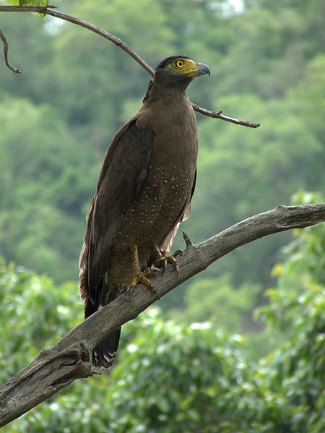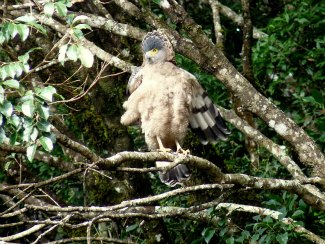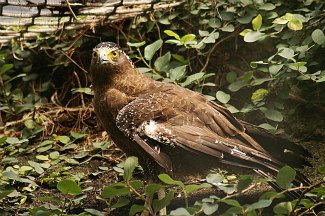Crested Serpent Eagle - Spilornis cheela
By K. Mohan Raj, CC-BY-3.0, via Wikimedia Commons
Family: Accipitridae
Genus: Spilornis
Species: S. cheela
Subspecies: S. c. batu, S. c. bido, S. c. burmanicus (Burmese Crested Serpent Eagle), S. c. cheela,
S. c. davisoni (Pale Andaman Serpent Eagle), S. c. hoya, S. c. malayensis, S. c. melanotis, S. c. minimus, S. c. palawanensis, S. c. pallidus,
S. c. richmondi, S. c. ricketti (Chinese Serpent Eagle), S. c. rutherfordi, S. c. spilogaster (Ceylon Serpent Eagle)
Crested Serpent Eagles are medium-sized eagles that live throughout Indochina and southern Asia, in a wide range of habitats. Classification of the subspecies of Spilornis cheela is currently under debate, since definitive conclusions about the relationships between separate populations requires more research.
Physical Description:
Generally, Crested Serpent Eagles are dark from above with a lighter brown underside. They have white spots and streaks on their wing coverts and scapulars and the underside of their flight feathers is black with broad white bands. The nape of neck and the crown are black, while the crest is brown and barred with white. The breast is barred or a solid color, and the belly, thighs, and crissum are rufous with dark barring and white spots. The tail is black with a white tip and thick white bar. The wings are short and broad. When the crest is raised in alarm, it frames the entire face. Legs are unfeathered, and the eyes are bright yellow.
The subspecies are very different in color when compared to each other. The nominate species S. c. cheela is the largest of
the subspecies and is dark brown from above with a thinly-barred breast and one tail band. The following subspecies are compared to the nominate
(if a characteristic is unmentioned, it is the same):
S. c. batu is smaller, and darker in color;
S. c. bido, medium-sized, has a dark breast and upperparts, and clear white spots on the belly;
S. c. burmanicus is lighter in color with more barring and browner cheeks and throat;
S. c. davisoni is paler with dark barring on the breast and two tail bands;
S. c. hoya is dark with black cheeks and throat and clear white spotting on underparts;
S. c. malayensis has dark brown cheeks and throat and white barring and spots on underparts;
S. c. melanotis is smaller and has gray cheeks and two tail bands;
S. c. minimus has a black head with brown underparts and clear white spotting on underside;
S. c. palawanensis is medium-sized with rufous barring;
S. c. pallidus also medium-sized, and darker;
S. c. richmondi is pale brown with gray cheeks and throat, and no barring on breast;
S. c. ricketti is pale brown with little spotting and barring;
S. c. rutherfordi is darker with clearer markings;
And, finally, S. c. spilogaster has a brown breast and gray cheeks and throat.
Juveniles have a white head, underparts, and underwing. They are dark brown from above with a buff underside, and have varying dark blotches and streaks.
Their call is a sharp "kii kii kii kiiluii". Listen to a Crested Serpent Eagle.
Size:
Length: 65-75 cm
Wingspan: 123-155 cm
Weight: 420 g-1.8 kg
Habitat and Distribution:
They occur in a wide range of habitats, including rain forest, open savannah, mangrove swamps, plantations, ravines, evergreen and deciduous forest, and tidal creeks. Crested Serpent Eagles tolerate habitat disturbance, as long as there are some large trees. They live from 0-1,500 meters above sea level, but go as high as 2,500 m in Taiwan and 3,350 m in Nepal. They are irruptive or local migrants.
Their range spans the Indian subcontinent and southern Asia, from the Himalayas, the Kashmir region, and Nepal east to Tibet, southern China, and the Malay peninsula, along with the Philippines, Indonesia, Borneo, and the Andaman Islands. Their total distribution size is 7,720,000 km², from 35°N to 9°S.
Diet and Hunting:
Most of their diet, as their name would indicate, is made up of snakes. However, they also catch lizards, frogs, toads, large insects, and small birds. Crested Serpent Eagles have also been known to catch eels and crabs.
By Peellden, CC-BY-SA-3.0, via Wikimedia Commons
They still-hunt from a perch, waiting for up to long periods of time before descending to the ground and snatching their prey. They often perch by clearings or streams, and may be hidden or exposed.
Reproduction:
Breeding displays consist of loud calling and soaring, along with rolling in the air.
The nest is made of sticks and lined with leaves, and it is placed 6-20 meters high in a range of different trees, often close to water. Both members of a pair of Crested Serpent Eagles contribute to building the nest, which is usually 50-60 cm wide and 10-30 cm deep. They sometimes—though not always—reuse old nests. Only one egg is laid and it is incubated by the female for 35 days. Fledging takes 60 days.
Conservation:
Crested Serpent Eagles have been evaluated as Least Concern by BirdLife International.
Taxonomy:
The taxonomic status of many subspecies of Spilornis cheela is currently under debate. The subspecies listed here follow the taxon set out by Ferguson-Lees and Christie in Raptors of the World (2001), except for the inclusion of S. c. minimus, which is considered by many other authorities to be a subspecies.
Subspecies:
There are 15 subspecies:
S. c. batu lives in southern Sumatra and Batu Islands;
S. c. bido in Java and Bali;
S. c. burmanicus (Burmese Serpent Eagle) in eastern Bangladesh, southern and eastern India, Myanmar, Thailand, and Indochina;
S. c. cheela in Pakistan, Kashmir, Nepal, Bhutan, Bangladesh, and India north of 25°N;
S. c. davisoni (Pale Andaman Serpent Eagle) in the Andaman Islands and possibly the Nicobar Islands;
S. c. hoya in Taiwan;
S. c. malayensis in southern Tenasserim, Thailand, Malaysia, Anambas (Indonesia), and Sumatra;
S. c. melanotis in India south of 25°N;
S. c. minimus in the Nicobar Islands (Terasa, Dwip, Camorta, Katchall, Trinkat, and Nancowrie);
S. c. palawanensis in Palawan (Philippines); S. c. pallidus in northern Borneo;
S. c. richmondi in southern Borneo; S. c. ricketti (Chinese Serpent Eagle) in southern China and
Tonkin (Vietnam);
S. c. rutherfordi in Hainan province in China;
And S. c. spilogaster (Ceylon Serpent Eagle) in Sri Lanka.
S. sipora (Andaman Serpent Eagle) was also classified as a subspecies of S. cheela, but is now considered a full species.
Other Names:
Orlík chocholatý (Czech), Borneoslangeørn (Danish), Indische Slangenarend (Dutch), Mägi-maduhaugas (Estonian), Harjakotka (Finnish), Serpentaire bacha (French), Schlangenweihe (German), Elang ular (Indonesian), Serpentario crestato (Italian), Kammuriwashi (Japanese), Helang Kuik (Malay), Orientsnokørn (Norwegian), Wezojad czubaty (Polish), Culebrera Chíla (Spanish), Indisk tofsormörn (Swedish).
Video of a Crested Serpent Eagle:
References:
http://avibase.bsc-eoc.org/species.jsp?avibaseid=E925C521AE375F34
BirdLife International (2011) Species factsheet: Spilornis cheela. Downloaded from http://www.birdlife.org on
13/11/2011.
http://www.gio.gov.tw/info/ecology/English/animals_e/LowAnimals_e/LowAnimals09_e.htm
Global Raptor Information Network. 2011. Species account: Crested Serpent Eagle Spilornis cheela. Downloaded from
http://www.globalraptors.org on 27 May. 2012
http://ibc.lynxeds.com/species/crested-serpent-eagle-spilornis-cheela
http://www.planetofbirds.com/accipitriformes-accipitridae-crested-serpent-eagle-spilornis-cheela
Ferguson-Lees, James, and Christie, David A. Raptors of the World. Houghton Mifflin Company, 2001.



